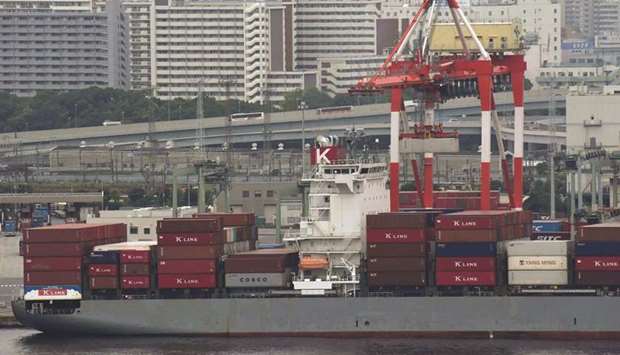Japan’s exports fell yet again in June, while manufacturers’ confidence crumbled to a three-year low this month as a Sino-US tariff row, slowing China growth and rising trade protectionism heaped pressure on the world’s third-biggest economy.
Weak exports have weighed on Japan’s factory output, threatening to undermine capital expenditure and denting policymakers’ hopes that domestic demand will help offset intensifying external strains.
Exports in June fell 6.7% from a year earlier, the seventh straight month of declines, Ministry of Finance data showed yesterday, dragged down by slowing sales of tankers, China-bound car parts and steel pipes.
That compared with a 5.6% drop expected by economists and a 7.8% fall in May.
Separately, the Reuters Tankan survey showed Japanese manufacturers’ business confidence hit a three-year low in July, dragged down by steel/nonferrous metals and precision machinery, highlighting the fragility of the export-led economy.
The batch of gloomy data underscored bets among some analysts that the central bank will roll out more stimulus at its policy review later in the month.
A Reuters poll of economists showed expectations have risen sharply that the Bank of Japan’s (BoJ) next policy move will be to ease further.
BoJ officials have said they remain ready to ease further if economic conditions worsen, joining the US Federal Reserve in signalling additional monetary stimulus amid deteriorating global growth.
“Both the government and the BoJ expect global economy to recover later this year but that scenario will likely be delayed due to intensified US-China trade war, worsening of Europe’s economy and the US economy heading to a soft landing,” Takeshi Minami, chief economist at Norinchukin Research Institute, said. “Japan’s exports will remain weak for the time being.”
Marcel Thieliant, senior Japan economist at Capital Economics, said he estimated that net trade knocked off 0.3 percentage points from gross domestic product growth in the second quarter and he expected that drag to persist through to the third quarter. Indeed, the economic strains showed no signs of abating as a lack of progress on US-China trade negotiations and heightened global uncertainty weighed on corporate spending.
Japan’s economy expanded an annualised 2.2% in the first quarter but many analysts predict growth will slow in the coming months due to the increasing external pressures.
October’s scheduled sales tax hike may also curb consumption, they warn.
Trade friction
US President Donald Trump and Chinese President Xi Jinping agreed last month to another truce in the year-long trade row between the world’s two largest economies, but no deadline has been set for the negotiations to conclude.
Adding to global trade uncertainties, Japan is in a deepening row with South Korea after Tokyo curbed exports of some materials used to make high-tech equipment.
By region, Japan’s exports to the United States rose 4.8% in the year to June, up for the ninth straight month, driven by semiconductor-making equipment and cars, the trade data showed.
The increased US-bound shipments raise some concerns that Trump could pile pressure on Japan to curb its auto exports to the United States and open its highly-protected agriculture market to fix what he calls unfair trade imbalances.
Imports from the United States fell 2.5% in the year to June, causing Japan’s trade surplus with the world’s biggest economy to increase 13.5% from a year earlier to ¥669.9bn ($6.21bn), the data showed.
Exports to China, Japan’s biggest trading partner, tumbled 10.1% year-on-year in June, down for fourth consecutive month. Asia-bound shipments, which account for more than half of Japan’s overall exports, declined 8.2% in the year to June.
Japan’s overall imports fell 5.2% in the year to June, led by nonferrous metal, versus the median estimate for a 0.4% fall, bringing the trade balance to a surplus of ¥589.5bn, against the median estimate for a ¥420bn surplus.
“The big drop in imports in June probably narrowed negative contribution from net exports to GDP.
But that won’t change our view that external demand likely put a drag on April-June growth,” said Koya Miyamae, senior economist at SMBC Nikko Securities.

A freighter is anchored at the international container pier at Tokyo port.
